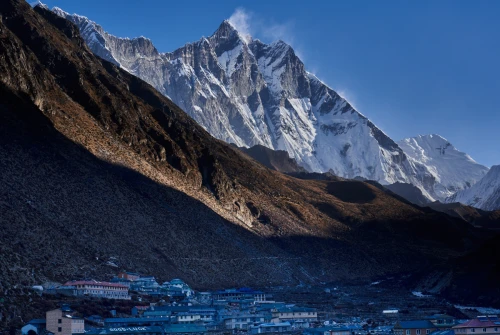The Everest Base Camp Trek 13 Days is more than just a journey; it’s a life-changing adventure that brings us face-to-face with the highest mountain on Earth, Mount Everest (8,848.86m). This legendary trail leads us through Sagarmatha National Park, past roaring rivers, ancient monasteries, hanging bridges, and friendly Sherpa villages, culminating in the epic moment we stand at the foot of the mighty Everest.
Whether you're drawn by the allure of the Himalayas, the spiritual serenity of the Khumbu region, or the sense of accomplishment that comes with reaching base camp, this trek delivers on every level.
Trek Overview
The Everest Base Camp Trek is one of the most iconic high-altitude trekking adventures in the world, offering a once-in-a-lifetime journey into the heart of the Khumbu region of Nepal. This legendary trek combines awe-inspiring Himalayan landscapes, rich Sherpa culture, and a deep sense of personal achievement. Whether you're a seasoned trekker or a first-time adventurer with moderate fitness, this 13-day Everest Base Camp itinerary is the perfect balance of challenge, safety, and unforgettable reward.
We begin with a thrilling mountain flight from Kathmandu to Lukla, landing at one of the world’s most famous high-altitude airports. From there, the trail winds through charming Sherpa villages, lush pine forests, and glacial valleys, offering ever-changing views of snow-capped peaks, including Ama Dablam, Thamserku, Lhotse, Nuptse, and the majestic Mount Everest (8,848.86m) itself.
This well-structured trek includes essential acclimatization days in key spots like Namche Bazaar (3,440m) and Dingboche, reducing the risk of altitude sickness (AMS) and allowing your body to adjust gradually as you climb to Everest Base Camp (5,364m). Along the way, you'll cross suspension bridges, pass colorful prayer flags, and visit sacred Buddhist sites like Tengboche Monastery, surrounded by towering peaks and the spiritual energy of the mountains.
A major highlight is the early morning ascent to Kala Patthar (5,545m)—a panoramic viewpoint known for its unrivaled sunrise views of Mount Everest, as well as Pumori, Makalu, and the surrounding peaks. It's the most photogenic moment of the journey and an emotional high point for many trekkers.
The Everest Base Camp trek is designed not just for those chasing a destination, but for those seeking a deeper connection with nature, culture, and themselves. You’ll be supported by experienced trekking guides and porters, stay in authentic mountain teahouses, and gain insight into the resilient and warm-hearted Sherpa people who call this region home.
Whether you're dreaming of mountain adventure, spiritual renewal, or ticking off a bucket-list trek, this journey delivers it all, with safe altitude management, a balanced pace, and unforgettable Himalayan magic.

What Is the Everest Base Camp Trek -All About?
The Everest Base Camp Trek 13 Days is a thoughtfully paced trekking itinerary designed for adventurers who want to experience the breathtaking beauty of the Everest region without feeling rushed. This package balances steady ascent with essential acclimatization stops, making it ideal for moderate fitness levels and first-time high-altitude trekkers.
Over the course of 13 days, trekkers will journey from Lukla (2,860 meters) through the iconic Sherpa villages of Namche Bazaar, Tengboche, and Lobuche, finally reaching the legendary Everest Base Camp at 5,364 meters. Along the way, the trek includes a visit to Kala Patthar (5,545 meters), renowned for its stunning sunrise views over Everest and the surrounding Himalayan peaks.
This trek is not only about magnificent mountain scenery but also offers deep immersion into Sherpa culture, traditional Buddhist monasteries, and the natural heritage protected within Sagarmatha National Park, a UNESCO World Heritage Site. You’ll have opportunities to interact with locals, learn about their customs, and appreciate their resilient way of life.
The itinerary is carefully planned to allow gradual acclimatization, reducing the risk of acute mountain sickness (AMS), and includes rest days that provide time to explore villages and absorb the unique environment. This 13-day trek ensures you return home with unforgettable memories, a greater respect for the Himalayas, and a personal sense of achievement.
Whether you seek adventure, cultural discovery, or spiritual connection, the Everest Base Camp Trek (EBC) offers a comprehensive and rewarding experience.

Where Is Everest Base Camp, and How Do We Get There?
Everest Base Camp (EBC) is located on the southern side of Mount Everest in the famous Khumbu Valley, within the Solukhumbu District of Nepal. The base camp lies inside the Sagarmatha National Park, a protected area designated as a UNESCO World Heritage Site known for its stunning landscapes and unique Himalayan biodiversity.
The journey to Everest Base Camp begins with an unforgettable flight from Kathmandu to Lukla, which takes approximately 35 minutes. This flight is renowned for landing at one of the most challenging high-altitude airports in the world, surrounded by towering Himalayan peaks. The Lukla airport serves as the gateway for almost all trekkers heading to EBC.
From Lukla, the trek spans roughly 7 days uphill, covering diverse terrain through Sherpa villages like Namche Bazaar, Tengboche, Dingboche, and Gorak Shep before reaching the iconic Everest Base Camp at about 5,364 meters (17,598 feet) above sea level. After spending time at EBC, trekkers usually take 4 to 5 days to descend back to Lukla.
This Everest Base Camp itinerary includes essential rest and acclimatization days to help your body adapt safely to the increasing altitude. Acclimatization stops in key villages help prevent acute mountain sickness (AMS) and ensure you can enjoy the trek comfortably. Whether you are an experienced trekker or a first-timer, this route offers breathtaking mountain views, rich Sherpa culture, and the chance to experience the grandeur of the world’s highest peak up close.

Why Choose the Everest Base Camp Trek?
The 13-day Everest Base Camp trek is widely regarded as the optimal balance between a safe, enjoyable pace and a rich, immersive experience in the Everest region. This itinerary offers several key advantages that make it the preferred choice for many trekkers: First and foremost, the 13-day trek incorporates full acclimatization days, especially in Namche Bazaar, one of the most important stops on the route. These rest days give your body time to adjust to the thinning air, significantly reducing the risk of acute mountain sickness (AMS) and other altitude-related issues, which is crucial for a successful high-altitude trek.
Another highlight of this itinerary is the inclusion of the iconic Kala Patthar sunrise hike. From Kala Patthar, trekkers witness breathtaking panoramic views of Everest, Lhotse, Nuptse, and Ama Dablam, some of the most stunning peaks in the Himalayas. This unforgettable experience is often cited as one of the trek’s most rewarding moments.
The 13-day plan is perfect for those who have a moderate fitness level and want to maximize both safety and enjoyment. Unlike the shorter, more rushed 10-day itineraries that leave little time for acclimatization, the 13-day trek allows a sustainable pace that keeps fatigue and health risks low.
At the same time, it’s not as long or logistically demanding as extended 16-day options, which can be physically and mentally exhausting for many trekkers. The 13-day itinerary strikes a “sweet spot” by delivering a comprehensive Everest Base Camp experience without unnecessary pressure or time commitments. In summary, the 13-day Everest Base Camp trek is the best choice for those who want a well-rounded, safe, and deeply rewarding adventure in Nepal’s Himalayas.
When Is the Best Time for the Everest Base Camp Trek?
The best time to embark on the Everest Base Camp trek largely depends on the season you choose, as each offers distinct weather patterns, trail conditions, and trekking experiences. Spring (March to May) is one of the most popular trekking seasons in Nepal due to its moderate temperatures and stunning natural beauty. During this time, the rhododendrons bloom in vibrant reds and pinks along the trails, and the skies are generally clear, offering spectacular and sharp views of iconic peaks like Everest, Lhotse, and Ama Dablam. The moderate daytime temperatures make it comfortable for trekking, although nights can still be chilly at higher altitudes. Spring attracts many trekkers, so you can expect lively trails and fully operational lodges, but it is important to book permits and accommodations early to avoid last-minute issues.
Autumn (September to November) is widely regarded as the best season for the Everest Base Camp trek because the monsoon rains have cleared the atmosphere, resulting in crystal-clear mountain vistas and stable weather conditions. This season boasts cool, dry air, excellent trail conditions, and vibrant autumn foliage that enhances the trekking scenery. Because of these ideal conditions, autumn is the peak trekking season with the highest number of visitors, so early planning is crucial to secure trekking permits and lodge reservations. The comfortable temperatures and reliable weather make autumn the preferred choice for many Everest trekkers seeking the safest and most visually rewarding experience.
In contrast, winter (December to February) brings colder temperatures, often dropping below freezing at night, and the possibility of snowfall at higher elevations. While trekking in winter offers the advantage of quieter trails and a peaceful atmosphere, it requires specialized cold-weather gear and experience coping with icy conditions. Winter trekkers benefit from clearer skies and stunning mountain views free from haze, but the cold can be challenging, especially for those not prepared for sub-zero temperatures and shorter daylight hours.
On the other hand, the monsoon season (June to August) is generally not recommended for the Everest Base Camp trek due to heavy, persistent rainfall that makes trails muddy, slippery, and dangerous. The increased risk of landslides and flooding during this time can cause trail closures and serious safety concerns. Additionally, the thick clouds and low visibility often obscure mountain views, diminishing the scenic allure of the trek. Many guesthouses and lodges close during the monsoon, limiting available accommodation and services. Although some adventurous trekkers still attempt the journey during monsoon, it is advisable to avoid this season unless you are an experienced mountaineer prepared for adverse weather.
In summary, the best seasons to trek to Everest Base Campare spring and autumn, offering a balance of favorable weather, excellent visibility, and safer trail conditions. Winter suits trekkers seeking solitude and crisp views, while monsoon trekking is fraught with hazards and is typically avoided. Careful planning around these seasons will greatly enhance your safety, enjoyment, and chances of completing the iconic Everest Base Camp trek.
Who Can Do This Trek?
The Everest Base Camp trek (13 days) is accessible to a wide range of adventurers, from moderately fit individuals to seasoned outdoor enthusiasts. You don’t need to be an expert mountaineer or have prior high-altitude trekking experience to complete this iconic journey, but good physical and mental preparation is essential.
This trek is ideal for trekkers with moderate fitness levels who are comfortable walking 5 to 7 hours daily on uneven terrain, often at high altitudes. The daily distances and elevation gains are manageable with steady pacing, and there are ample opportunities for rest, hydration, and acclimatization. Even if this is your first high-altitude trek, the Everest Base Camp route is well-established with numerous teahouses, lodges, and professional support available. Many people without prior mountaineering experience attempt this trek every year, relying on expert guides and porters who provide logistical assistance and help carry heavy loads. This support allows you to focus on enjoying the stunning landscapes and gradually adjusting to the altitude.
A typical day on the trek involves 5 to 7 hours of walking, usually broken into manageable sections with plenty of breaks. If you can comfortably walk 5–6 hours a day for 10 or more consecutive days carrying a backpack, you are physically capable of undertaking this trek. Successful trekkers prioritize proper pacing, hydration, and nutrition along the way and listen carefully to their bodies to avoid altitude sickness. Mental resilience is equally important, as the trek tests both endurance and adaptability to changing weather and terrain.
In summary, the Everest Base Camp trek is suitable for anyone with a reasonable level of fitness and a spirit of adventure who is willing to prepare and take the necessary precautions. With the right mindset and support, this once-in-a-lifetime journey is achievable for many travelers.
What Permits Do You Need for the Trek?
Before starting your Everest Base Camp trek, securing the correct permits is essential to comply with Nepalese regulations and support conservation efforts in the region. The two main official permits required for the trek are the Sagarmatha National Park Entry Permit and the Khumbu Rural Municipality Entry Permit.
The Sagarmatha National Park Permit allows you to enter this protected area, home to Mount Everest and its surrounding peaks. This permit helps fund park maintenance, wildlife protection, and local community projects. The permit fee varies depending on the season and your nationality, so it’s advisable to check current rates before your trek.
Additionally, you need the Khumbu Rural Municipality Entry Permit, which grants access to the local administrative areas in the Everest region. This permit supports local infrastructure development and sustainable tourism initiatives.
It is important to note that since 2020, the TIMS (Trekkers’ Information Management System) card is no longer required for trekking within the Khumbu region, including the Everest Base Camp route. This change simplifies the permit process and reduces paperwork for trekkers.
Permits are usually checked at multiple checkpoints along the trail, so always carry your permits with you, along with your passport, passport-sized photos, and trekking insurance documents for verification. Lost permits can cause delays or fines, so keep these documents secure throughout your journey.Most trekking agencies can assist with permit acquisition, but you can also obtain them in Kathmandu or at the park entrance in Monjo. Ensure you arrange your permits well before starting the trek to avoid any administrative issues.
How Challenging Is the Everest Base Camp Trek?
The Everest Base Camp trek is considered a moderately challenging high-altitude trek, with altitude posing the biggest obstacle for most trekkers. Although the route involves no technical climbing or mountaineering skills, walking daily at elevations often above 4,000 meters (13,000 feet) requires careful acclimatization and physical preparation to avoid altitude sickness.
Along the trek, you’ll encounter varied terrain that includes crossing suspension bridges, navigating steep ascents and descents, and hiking on rocky, uneven trails. The combination of physical exertion and the thin, oxygen-poor air at high altitude means your body must work harder, making the trek more demanding than typical lowland hikes.
However, the popular 13-day Everest Base Camp itinerary is designed to gradually increase your altitude exposure, allowing your body time to adapt. Built-in rest days and acclimatization hikes at key stops like Namche Bazaar and Dingboche help reduce the risk of acute mountain sickness (AMS).
Trekking with experienced local guides and porters provides essential support and expertise. Guides monitor your health, help manage pacing, and ensure you follow best practices for acclimatization and safety. Porters assist by carrying heavy gear, allowing you to conserve energy for the challenging terrain.
With proper physical training, hydration, balanced pacing, and mental determination, most moderately fit trekkers can complete the Everest Base Camp trek. The key is listening to your body, respecting altitude limits, and not rushing the ascent. In summary, while the Everest Base Camp trek demands endurance and altitude acclimatization, it is achievable and rewarding for those prepared for its unique challenges.
How Safe Is the Everest Base Camp Trek?
With a certified trekking guide, a well-planned itinerary, and proper altitude sickness precautions, the Everest Base Camp trek is considered very safe for most trekkers. Safety on this high-altitude journey depends largely on preparation, awareness, and access to emergency support. Here’s how safety is ensured throughout the trek: The standard 13-day Everest Base Camp itinerary includes two essential acclimatization stops, typically in Namche Bazaar and Dingboche, which allow your body to adjust gradually to higher elevations and reduce the risk of acute mountain sickness (AMS).
Trekking agencies require all participants to have emergency evacuation insurance, covering medical emergencies and helicopter rescue if necessary. This is critical in the remote Himalayan region where access to hospitals is limited. Experienced guides carry pulse oximeters to monitor your oxygen saturation and first-aid kits to manage common ailments on the trail. Their training helps identify early warning signs of altitude sickness and other health issues so that swift action can be taken.
Along the route, lodges and teahouses provide hot meals and safe drinking water, crucial for maintaining strength and hydration, two key factors in staying healthy at altitude. Many trekkers use water purification methods like filters or iodine tablets for extra safety. In case of serious altitude sickness or injury, helicopter evacuation services are available but depend on having the appropriate insurance coverage. Helicopter rescues, while costly, are life-saving options for emergencies beyond the scope of an on-foot descent.
Every year, thousands of trekkers complete the Everest Base Camp trek without incident. The difference between a safe, enjoyable trek and a hazardous one is largely about being well-prepared, pacing yourself, and responding promptly to any symptoms. In conclusion, with the right guide, itinerary, equipment, and mindset, the Everest Base Camp trek can be a safe and unforgettable adventure.
Final Thoughts: Is the Everest Base Camp Trek Worth It?
Yes. Absolutely. Without a doubt.
In just under two weeks, the 13-day Everest Base Camp trek offers a truly life-changing Himalayan adventure that combines nature, culture, challenge, and triumph. As you trek through the legendary Khumbu region of Nepal, every step draws you deeper into a world of snow-dusted peaks, ancient Buddhist monasteries, prayer-flag-lined trails, and the warm hospitality of the Sherpa people.
This trek takes you through lush rhododendron forests, across high suspension bridges, through famous mountain towns like Namche Bazaar, and ultimately to the foot of Mount Everest, the highest mountain on Earth at 8,848.86 meters.
At Everest Base Camp (5,364m), you’ll be surrounded by glaciers, prayer stones, and trekkers from around the globe. But the real emotional peak often comes at Kala Patthar (5,545m), where a pre-dawn hike rewards you with a panoramic sunrise view of Mount Everest, Lhotse, Nuptse, and Ama Dablam bathed in golden light and framed by the crisp silence of the high Himalayas.

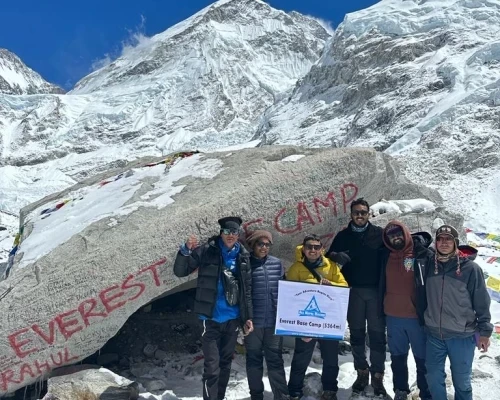
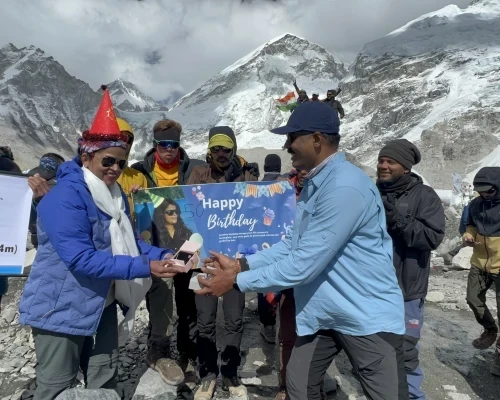
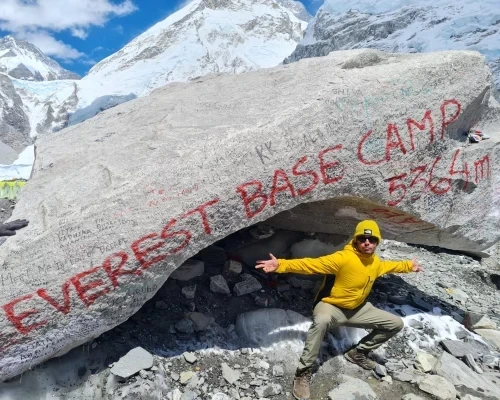
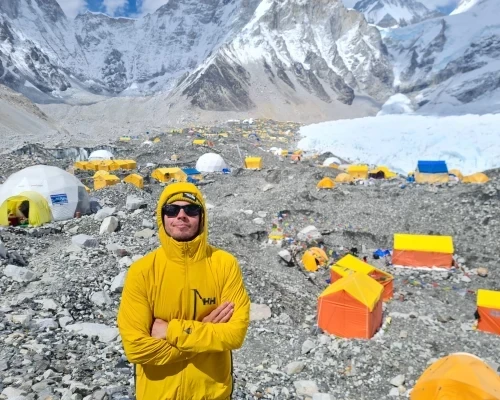
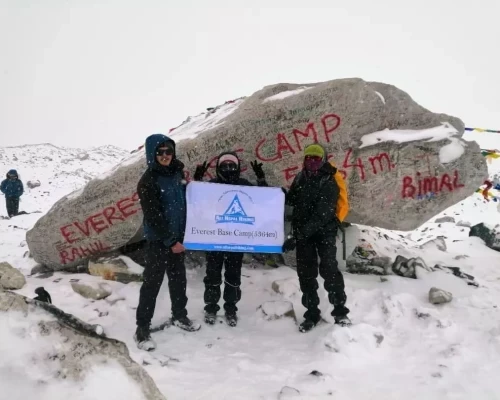
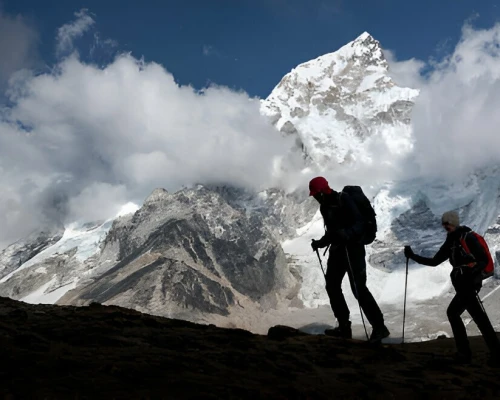
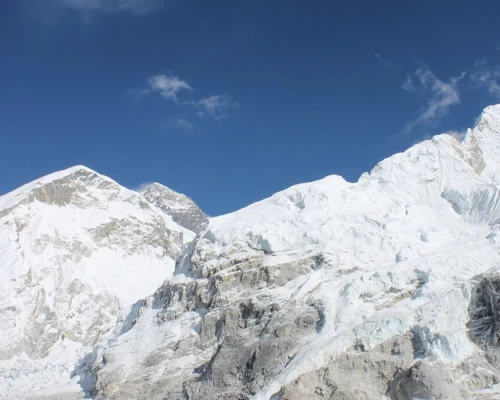
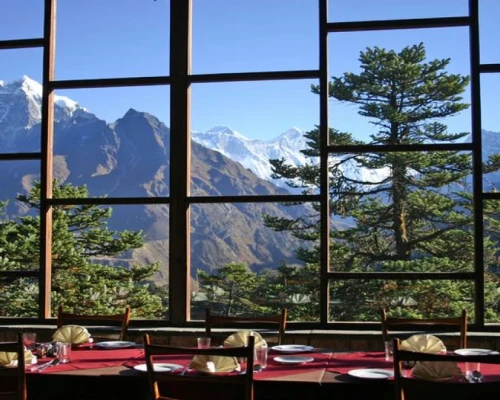
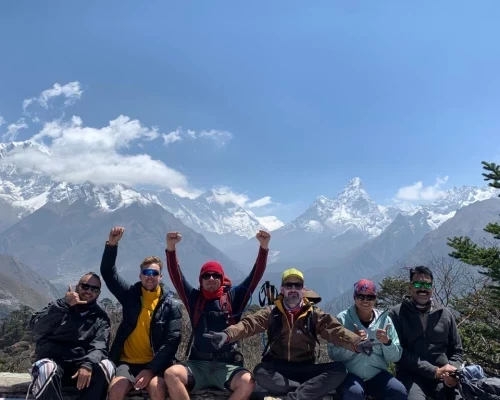
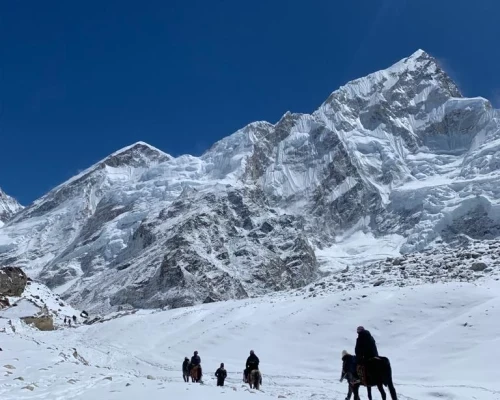
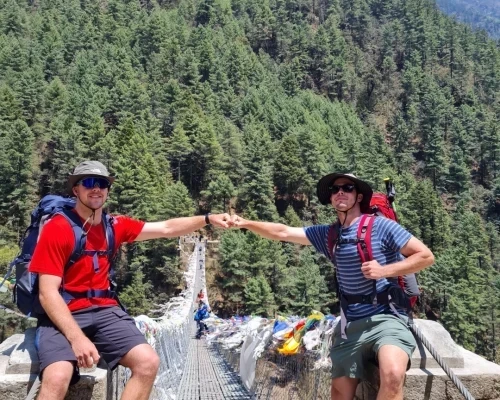
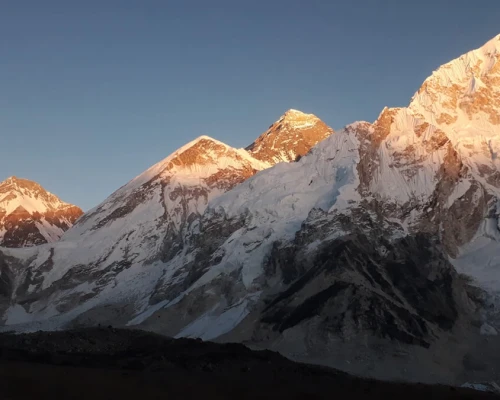
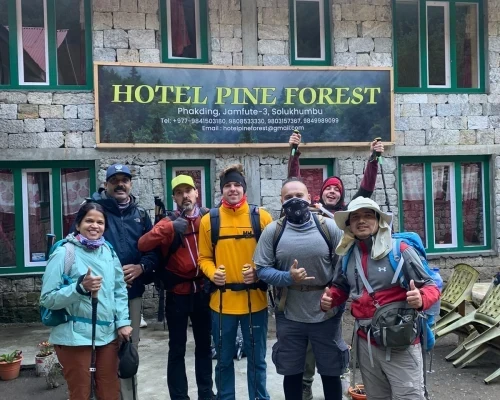
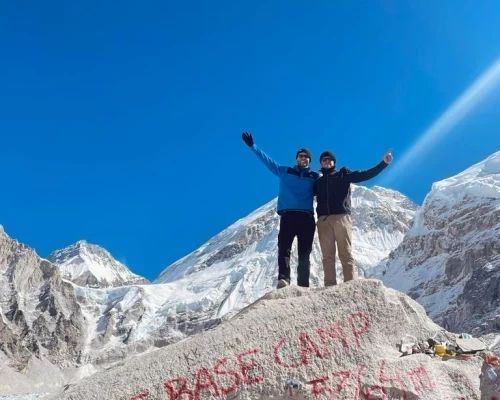
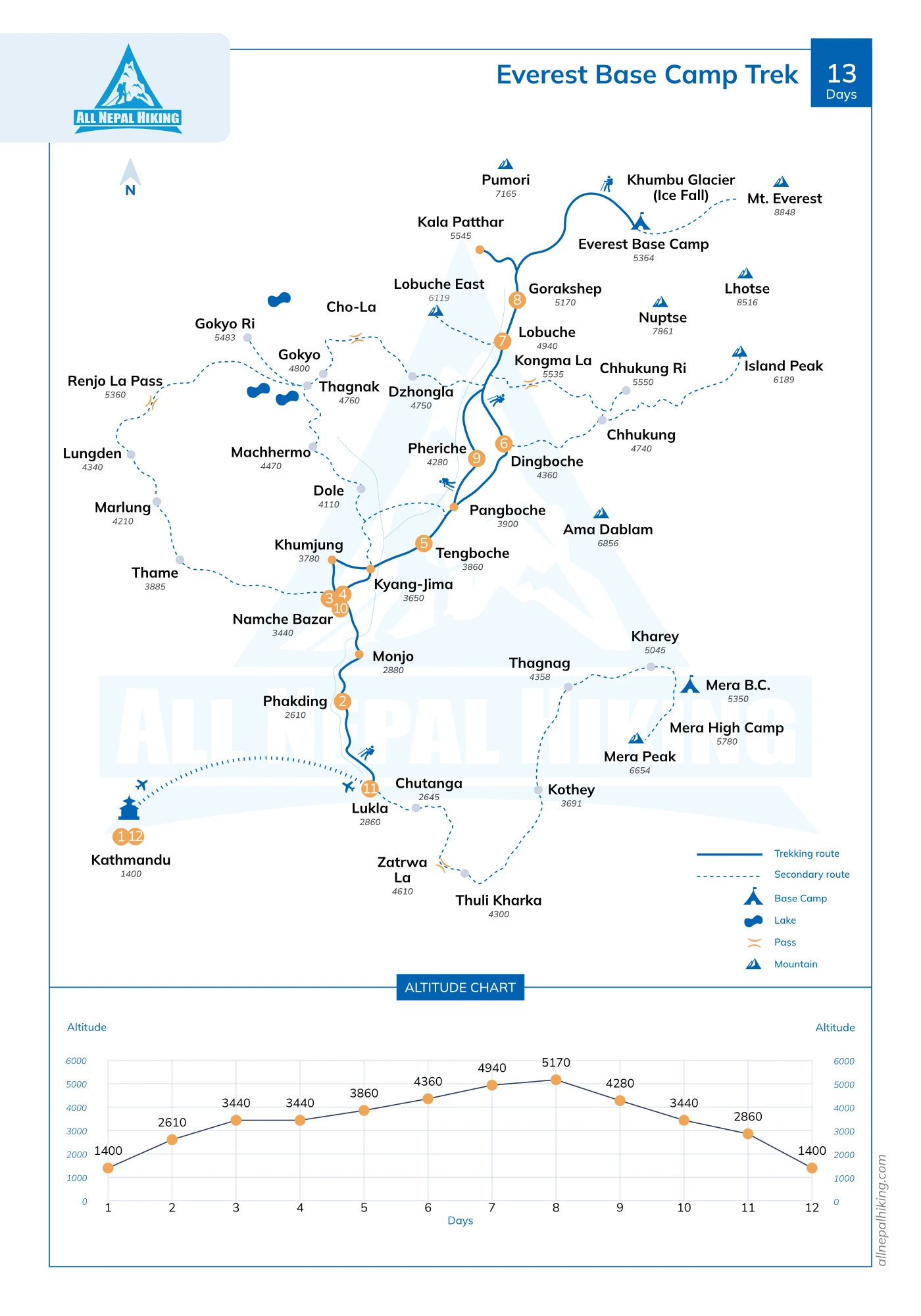

 based on 9 reviews
based on 9 reviews